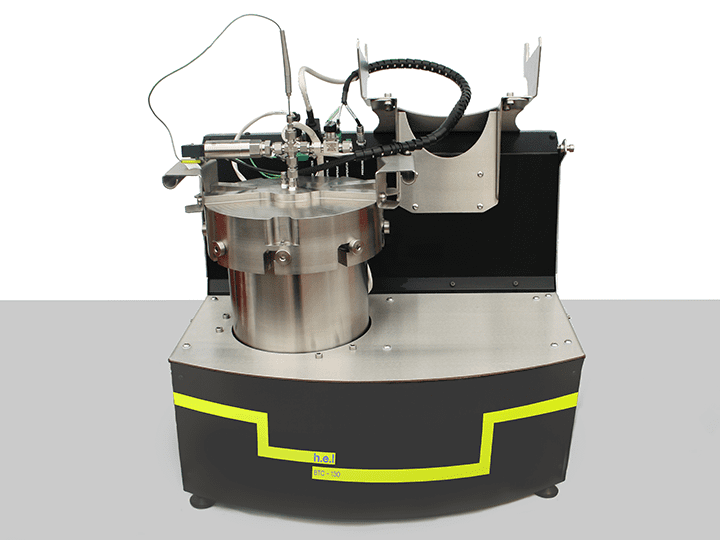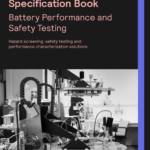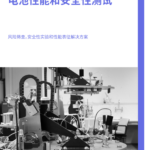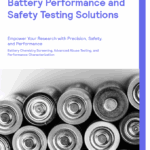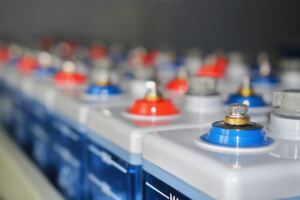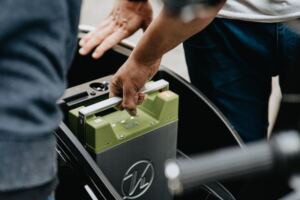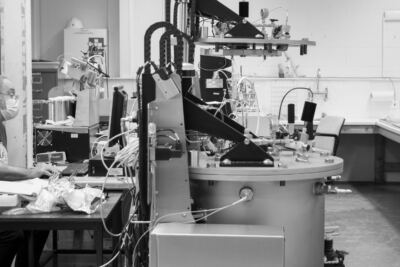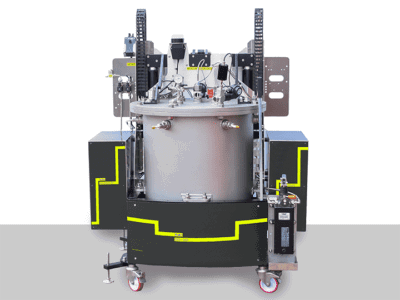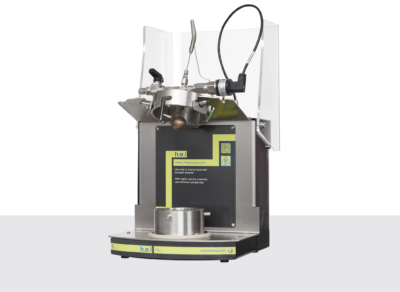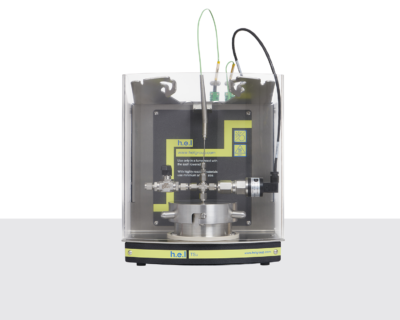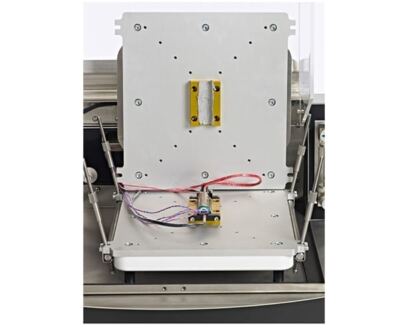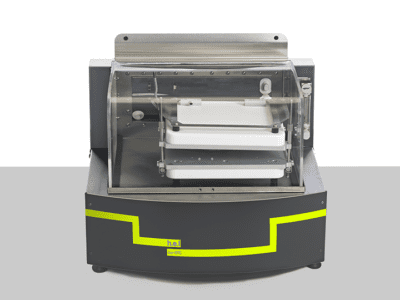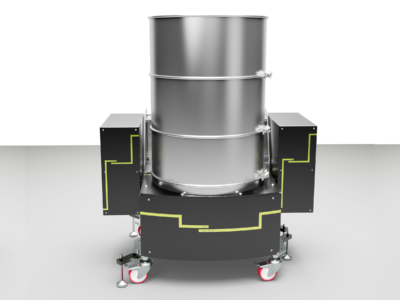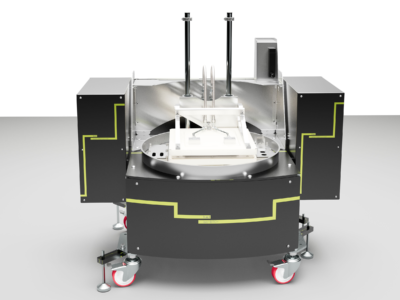BTC-130 | Bench-Top, Battery Safety Testing, Adiabatic Calorimeter
The BTC-130 (Battery Testing Calorimeter) is a bench-scale adiabatic calorimeter designed to enable the testing of thermal, electrical, and mechanical stress tests on smaller-sized battery cells. Evaluation of these tests facilitates the assessment of the safety performance of battery cells, the battery’s safe operating limits, and research and development into the mechanisms of thermal runaway. The BTC-130 also supports the use of small-volume spherical test cells, enabling thermal stability screening of individual battery cell components under adiabatic conditions.
- Component hazard Screening
- Characterizing differences in cell performance
- Defining safe operating limits
- Exploring thermal runaways and thermal propagation
Applications
Safety Testing
Component hazard screening:
- Batteries are used in a wide variety of environmental conditions and undergo internal heating and cooling from both normal use and stress conditions. Therefore, it is vital to understand how individual cell components will behave under a range of temperatures early on in development. If a new cell component has a low temperature of self-heating, it could pose a thermal runaway risk. Similarly, if a rapid increase in pressure accompanies a thermal event, or if toxic gases are produced, this may indicate the use of the component should be reassessed. The BTC-130 facilitates the use of small volume test cells in addition to supporting the testing of small battery cells. This enables the thermal stability of individual cell components to be assessed under adiabatic conditions and informed decisions on how to proceed with cell development to be made.
Define safe operating limits:
- It is essential to identify the safe operating limits of battery cells, modules, and packs in order to avert the risk of thermal runaway, and the potentially catastrophic consequences to which it could lead. Therefore, batteries need to be subjected to mechanical, electrical, and thermal stresses in order to define their safe operating limits.
- Thermal stability data from thermal stress tests can help define the safe working temperature of the battery
- The evaluation of over-charging and discharging rates allows the maximum safe voltage and maximum safe current to be determined
- The consequences of mechanical stresses and external short circuits (ESC) can be evaluated
Exploring thermal runaways and thermal propagation
- In general, most extreme conditions can result in thermal stress on the battery cell, which can lead to a thermal runaway. Therefore, for the development of safe batteries, it is essential to understand the mechanism of the thermal runaway in a cell, and how it propagates within a module or pack so that appropriate mitigation strategies can be implemented.
The data obtained from the stress tests performed in the BTC-130 and the BTC-500 can be used to model a cell’s predicted thermal behavior. Successive onset temperatures of decomposition of components within the cell can be detected, and the resultant heat released determined. This can help to facilitate a mechanistic understanding of the thermal runaway within the cell. Further insight can also be derived from the external analysis of the composition of any evolved gases collected.
Performance Testing
Characterize differences in cell performance
- The BTC-130 and BTC-500 can be used to characterize the cell performance under more extreme operating conditions. The absolute limit of safe, repeated use can be assessed with the automated cycling of the battery cell until the heat generated by its discharge causes the onset of self-heating. Similarly, puncture tests provide an indication of the structural stability of the cell.
Find out more in our guide Solutions in Battery Technology Testing: Hazard screening, safety testing and performance characterization
Application Notes:
On-Demand Webinars:
- Key Benefits of isothermal and adiabatic calorimetry battery testing
- The Use of Isothermal Calorimetry in Battery Performance Testing
Blogs:
- Best Publications on Battery Testing to Read Now – Part 1
- Best Publications on Battery Testing to Read Now – Part 2
Videos:
- Heat Wait Search Video Using H.E.L Battery Testing Calorimeters (BTC)
- With The H.E.L BTC 130 the maximum temperature of the environment which results in a battery thermal explosion that can be predicted by placing the sample in the BTC and performing well-established adiabatic tests. This involves stepwise heating, followed by a wait-and-search period that can be used with cells and large battery packs alike to determine the maximum safe operating temperature.
Publications
The following are a list of some technical publications which highlight the use of the equipment.
Revealing the failure mechanisms of lithium-ion batteries during dynamic overcharge
Guangxu Zhang, Xuezhe Wei, Jiangong Zhu, Siqi Chen, Guangshuai Han and Haifeng Dai
30-Sep-2022
https://www.sciencedirect.com/science/article/abs/pii/S0378775322008552(Subscription or purchase maybe required for full access)
Robust Self-Standing Single-Ion Polymer Electrolytes Enabling High-Safety Magnesium Batteries at Elevated Temperature
Xuesong Ge, Fuchen Song, Aobing Du, Yaojian Zhang, Bin Xie, Lang Huang, Jingwen Zhao, Shanmu Dong, Xinhong Zhou and Guanglei Cui
29-Jun-2022
https://onlinelibrary.wiley.com/doi/abs/10.1002/aenm.202201464(Subscription or purchase maybe required for full access)
Thermal runaway routes of large-format lithium-sulfur pouch cell batteries
Lang Huang, Tao Lu, Gaojie Xu, PengxianHan, Guanglei Cui, Liquan Chen
20-Apr-2022
https://www.cell.com/joule/pdf/S2542-4351(22)00096-4.pdf(Subscription or purchase maybe required for full access)
High performance polyimide-based separator for 4.5V high voltage LiCoO2 battery with superior safety
Kecong Yang, Zelin Liu, Jingchao Chai, Yun Zheng, Xiangnan Fu, Yang huan Shen, Jia Chen, Zhihong Liu and Shengwei Shi
15-Apr-2022
https://www.sciencedirect.com/science/article/abs/pii/S0254058422002814(Subscription or purchase maybe required for full access)
Revealing the multilevel thermal safety of lithium batteries
Gaojie Xu, Lang Huang, Chenglong Lu, Xinhong Zhou, Guanglei Cui
01-Oct-2020
https://doi.org/10.1016/j.ensm.2020.06.004(Subscription or purchase maybe required for full access)
Effects of Overdischarge Rate on Thermal Runaway of NCM811 Li-Ion Batteries
Dong Wang, Lili Zheng, Xichao Li, Guangchao Du, Zhichao Zhang, Yan Feng, Longzhou Jia and Zuoqiang Dai
30-Jul-2020
https://doi.org/10.3390/en13153885(Subscription or purchase maybe required for full access)
Reduced shuttle effect by dual synergism of lithium–sulfur batteries with polydopamine-modified polyimide separators
Yanqing Wang, Zengqi Zhang, Lintao Dong, Yongcheng Jin
01-Feb-2020
https://doi.org/10.1016/j.memsci.2019.117581(Subscription or purchase maybe required for full access)
Deciphering the Interface of a High Voltage (5 V-Class) Li-Ion Battery Containing Additive-Assisted Sulfolane-Based Electrolyte
Di Lu,Gaojie Xu,Zhiwei Hu,Zili Cui,Xiao Wang,Jiedong Li,Lang Huang,Xiaofan Du,Yantao Wang,Jun Ma
06-Sep-2019
https://doi.org/10.1002/smtd.201900546(Subscription or purchase maybe required for full access)
Downloads
The following are a list of available downloads.

We at TUV Rheinland consider ourselves to be quite fortunate in finding a vendor like H.E.L as the supplier of our Adiabatic Battery Testing Calorimeter. Not only does HEL provide a dynamic, but also a flexible team to work with. H.E.L’s expertise and experience in calorimetry has proven to be one of their strongest assets. The joint partnership with H.E.L has enabled us to develop services from which our company and our customers have benefited. We feel this BTC system has been a key factor to the success of our laboratory.
Japan - TUV Rheinland Battery Laboratory
Industries and Applications
Research & Development
Advanced testing for new battery chemistries and cell designs. Optimize battery safety designs with electrolyte,…
Manufacturing Quality Control
Battery testing and quality verification in OEM factories. Uncover electrochemical and decomposition reactions sending cells…
Electric Vehicles
Safety and performance testing for EV battery cells. Validate thermal stability under real world worst…
Consumer Electronics
Quality assurance testing for batteries used in smartphones, laptops, and wearable technology. Ensure safety and…
Power Storage
Comprehensive testing for grid storage batteries and power backup systems. Ensure safety and reliability for…
Battery Safety Testing
Design Safe Battery Chemistries and Cell Components

